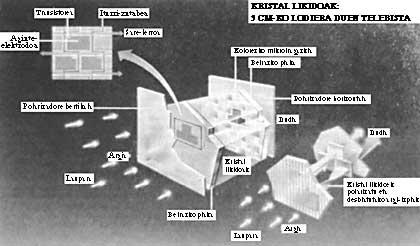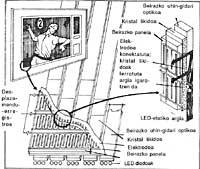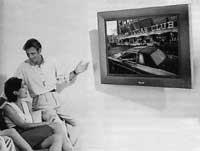Television
1996/01/01 Irureta Azkune, Onintza Iturria: Elhuyar aldizkaria
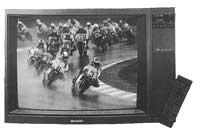
The most solid project was carried out by the German student Paul Nipkow in 1884. Nipkow established a photoelectric cell behind the image explorer disk, formed by holes. As the disc began to spin, the holes traced the image by projecting it into the photoelectric cell. For the reconstruction of the image the neon tube was used, which placed a second disc behind the tube and the turning system with the first.
Nipkow's project was implemented by the Scottish John Logie Baird in 1926. It used an electronic tube that allows the recovery of weak photoelectric currents and a Hertzian wave that joins two points away from each other, allowing it to emit a small figurine explored in twenty-eight rows. Therefore, Baird was the first to convert images into electrical signals using electromechanical procedures.
The most complete electrical system was that of Vladimir Zworykin. Using a vacuum tube called a lconoscope, he projected the images into a mosaic of small photoelectric cells. The electronic beam explores the photoelectric cells collecting their electric charge.
The television apparatus reproduces images and sounds emitted by electromagnetic waves or by electric current. These audio and video signals can be received directly (instantly) or indirectly (deferred). But how do images and sounds come to our TV? Audio and video signals reach the antennas we have on our roofs using electromagnetic waves. (Currently, however, the mentioned system is being replaced by the cable television system, although the structure is still incipient).
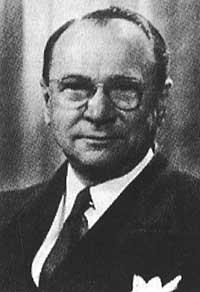
The signals come quite weak, so they are amplified. The next step is demodulation, i.e. separation of audio and video signals. The audio signal will be directed to the speakers and the electrical signal will become acoustic, i.e. sound. The video signal is directed to the cathodic ray tube, where it will go from being an electric signal to being the image we see on the screen.
How is the electrical signal transformed into an image? If we explore it inside the television, we will see that inside a cover there is a cannon. The electrical signals that reach this cannon indicate the output of the electrons to the screen. Each of the images we see on the screen consists of six hundred and twenty-five lines (five hundred and twenty-four lines in the United States). Although the vision of the human being simultaneously perceives the image as a whole, it forms linearly in a very short time.
Electrons coming out of the cannon begin to explore the first pixel of the first line or the image element. Odd lines are first explored (1 to six hundred and twenty-five) and then pairs (2 to six hundred and twenty-four). At each end of the line the electric voltage is lowered to zero (the barrel does not emit electrons) and the synchronous line beat is created. Meanwhile, the electron beam is placed on the next line to start again without losing any load of electrons.
All odd lines form an image area. Once the area has been scanned synchronously, the process will begin again with the image area forming the even lines. At the end of both areas, the image will appear on screen visibly. With the renewal of the process the first pixel of the first line will be resumed to complete the second image.
The above is a basic process. Regarding colour television, internal mechanisms vary slightly. Unlike black and white, on color television we find three cannons for cathodic rays: red, green and blue.
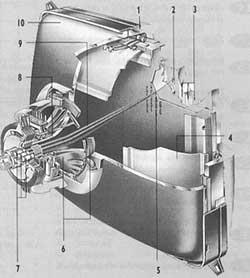
When the image signal enters through the antenna it will be divided into a chromatic carrier with red, green and blue information and a luminance wave with color light. These waves will become electrical signals and after the union of the three colors and the luminance in the matrix, each color will be driven to the corresponding cannon. Then the electron beam corresponding to each color will scan the network behind the screen. This network is full of holes and the rays that will pass through it, will collide against a mosaic of dots, illuminating the right color.
Three separate monochromatic images appear on the TV screen. The proximity between the image points makes the viewer perceive a single polychromatic image.

Gai honi buruzko eduki gehiago
Elhuyarrek garatutako teknologia




